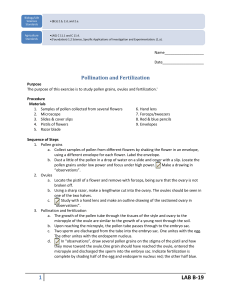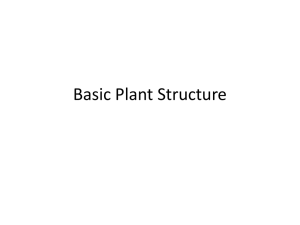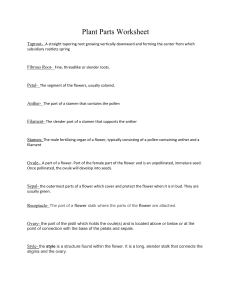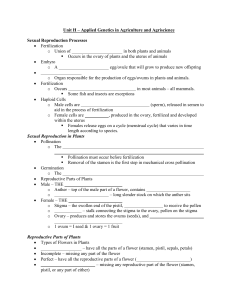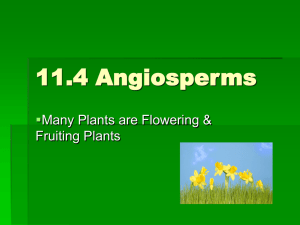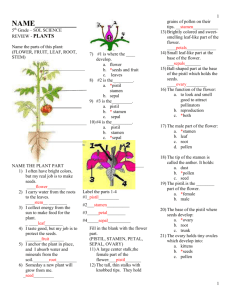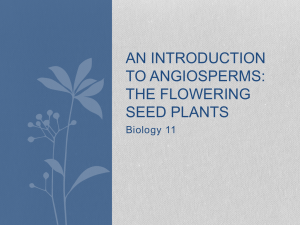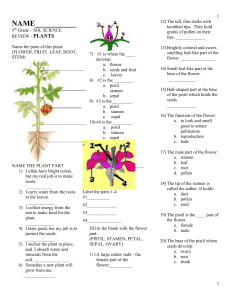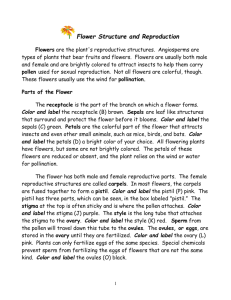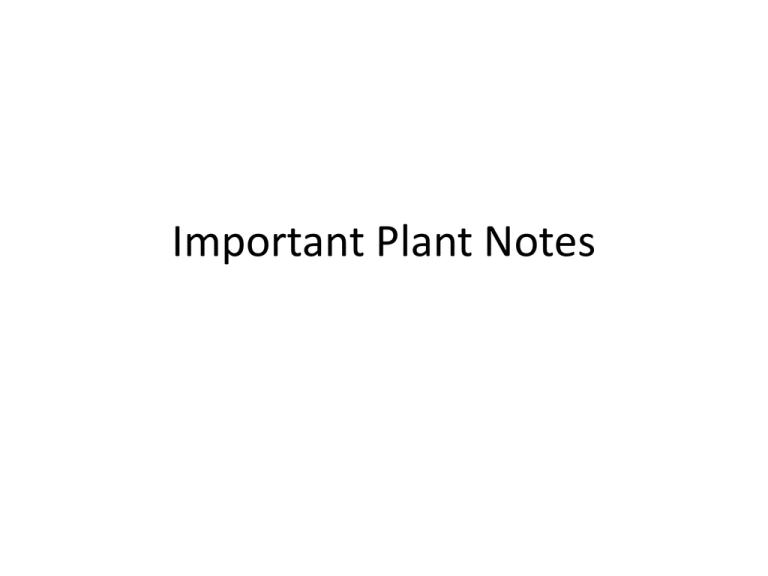
Important Plant Notes
Review…..
Fungi- NOT Plants……Why?
•
•
•
•
Heterotrophic- no chlorophyll
Eukaryotic – multicellular
Made up of slender filaments called hyphae
Have cell walls made of chitin (Plant cell walls
are made up of cellulose)
• Decomposers: Secrete enzymes and digest
food outside their body, then absorb nutrients
• Molds, yeasts, mildews, mushrooms
Review…
Lichen
• Mutualisitic association between a fungi and either a green
algae or a cyanobacteria
• The Fungus absorbs water/nutrients from the environment,
and the algae uses this for photosynthesis.
• The fungus absorbs the organic molecules made from
photosynthesis for its’ food.
• Used to test air quality:
Algae is very susceptible to Air/water pollution
Reproduction
Plants have Alternation of Generations
• Gametophyte: The haploid form of the plant
that produces the gametes. Haploid = half the
number of chromosomes- Male, female
In a moss….this is the ‘carpet’ you see
• Sporophyte: When 2 gametes fuse they form
the sporophyte (the diploid form of the plant)
PLANTS
NONVASCULAR
VASCULAR, seedless
• Ex: mosses, liverworts
• Waxy cuticle covering to
survive drought
• Transport materials (food)
by osmosis and diffusion
so need a large water
supply, need to be small
• Reproduce with spores
• Dominant Gametophyte
generation (Haploid)
(the ‘carpet’ that you see)
• Ex: ferns, horsetails
• Waxy cuticle covering to
survive drought
• Vascular: larger, more
complex. Can carry
nutrients from the soil,
sun throughout the plant
• Reproduce with spores
• Dominant Sporophyte
generation (Diploid)
(leaves that you see)
BOTH STILL NEED TO LIVE IN A MOIST ENVIRONMENT FOR REPRODUCTION
PLANTS: Vascular, with Seeds
GYMNOSPERMS vs ANGIOSPERMS
Gymnosperms (gymno = naked; sperma = seed),
seeds develop on the surface of the reproductive
structures (thus also called the “naked-seed
plants”) such as the cones in pine
Angiosperms (angio = vessel, receptacle,
container), seeds develop within a specialized
structure, called an ovary, on the adult
sporophyte (also called the “flowering plants”).
VASCULAR SYSTEMS
XYLEM
• System of tubes and
transport cells that circulate
water and dissolved
minerals
• Rings in a cut down tree
trunk are the remains of old
xylem tissue- one ring for
each year of life
PHLOEM
• System of tubes that
transports sugars and other
molecules created by the
plant from photosynthesis
• Always alive- xylem dies
after one year and then
develops new (the rings of a
tree trunk.
• The dripping sap from a tree
usually comes from phloem
THE
VASCULAR
SYSTEM
XYLEM
Goes up From the
roots
PHLOEM
Goes Down (Or Up)
Plants: Vascular: with NAKED Seeds!!
GYMNOSPERMS
MEGASPORES
MICROSPORES
FEMALE
MALE
POLLEN
•Seeds develop on the surface of the reproductive structures
•Sporophyte is the dominant generation
•Which is the Megaspore? Microspore?
•Which is the Male pinecone? Female?..............POLLEN?
PLANTS WITH SEEDS: ANGIOSPERMS
Flower Basics
1. Label the parts of the flower.
Petals
Stigma
Pistil
Anther
Style
Stamen
Filament
Ovule
Sepal
Ovary
Image: http://www.smithlifescience.com/SciFlowerDiagramBlank.jpg
2. Identify each part of the flower described below using the words in the word list.
_________________
- The female part of a flower
PISTIL
Word List:
_________________
- A small plant that is just starting to grow
SEEDLING
Anther
_________________
- The place where pollen develops and is stored
ANTHER
Fertilization
_________________
The
female
sex
cell
in
a
plant
OVARY
Filament
_________________
FERTILIZATION - Occurs when the sperm and egg cells unite
_________________
- A sugary substance that attracts insects
NECTAR
_________________
- The male sex cell in a plant
POLLEN
_________________
- The male part of a flower
STAMEN
_________________
- The stalk that supports the anther
FILAMENT
_________________
- The part of the pistil that receives the pollen
STIGMA
_________________
- Part that connects the stigma and ovary
STYLE
_________________
- Protective leaf-like enclosure for the flower bud
SEPAL
_________________
- The ripened ovary of a plant that contains seeds
FRUIT
Fruit
Imperfect
Nectar
Ovary
Perfect
Petals
Pistil
Pollen
Seedling
Sepals
Stamen
Stigma
Style
_________________
- Flower that contains both male and female parts
PERFECT
_________________
IMPERFECT - Flower that lacks either male or female parts
_________________
- The structures that make up the outside of the flower and maybe
PETALS
colored or contain nectar or perfume glands
3. What is the difference between self-pollination and cross-pollination?
SELF-POLLINATION: POLLEN FROM A FLOWER LANDS ON THE PISTIL OF
THE SAME FLOWER OR A FLOWER ON THE SAME PLANT.
CROSS-POLLINATION: POLLEN FROM A FLOWER LANDS ON THE PISTIL
OF THE A FLOWER ON A DIFFERENT PLANT.
Pollinators
Ants
Bats
Bees
Moths
Birds
Butterflies
Flies
Beetles
True Bugs
Wasps
Did you know?
Honey bees are the most
common pollinators. What
insect comes in second place?
Cotyledon
•The stored food for
the seed as it
develops; the first
embryonic leaves of a
seed plant•The Number of
Cotyledons places the
plant in a different
CLASS in the
Classification System:
•Monocot: If it has
one cotyledon
•Dicot: If it has two
cotyledons




